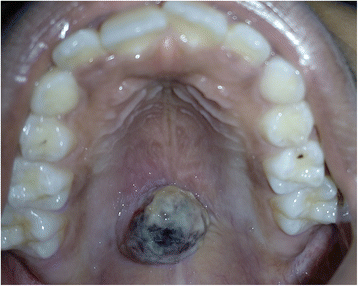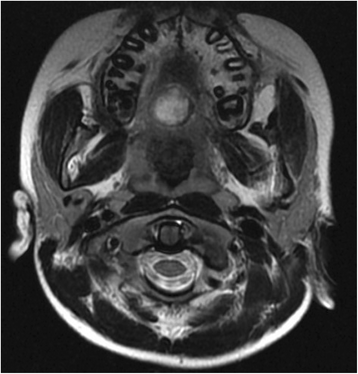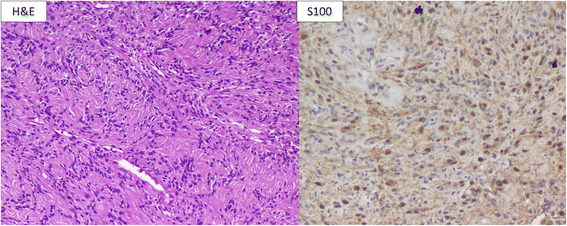Unusual neoplasm on the hard palate of a child: a case report
- PMID: 28577557
- PMCID: PMC5457591
- DOI: 10.1186/s13256-017-1321-4
Unusual neoplasm on the hard palate of a child: a case report
Abstract
Background: Myoepitheliomas account for less than 1% of salivary gland tumors. They mostly affect the parotid glands of adults during the third to fifth decades.
Case presentation: A 10-year-old Indian boy reported a small swelling in the roof of his mouth of 10 days' duration. History revealed that the lesion was painless and not associated with bleeding or pus discharge. On examination, a purplish well-circumscribed growth was noted on his posterior hard palate. Magnetic resonance imaging was suggestive of a well-encapsulated hemangioma. An excisional biopsy was performed and histopathology along with immunohistochemistry analysis showed that the lesion was a spindle cell variant of benign myoepithelioma.
Conclusion: Palatal myoepitheliomas are rare and their occurrence in young individuals is rarer.
Keywords: Hemangioma; Myoepithelioma; Oral cavity; Pediatric; Salivary gland tumor.
Figures



Similar articles
-
Plasmacytoid myoepithelioma of the soft palate: a review of the literature and report of a case with immunohistochemical findings.Kulak Burun Bogaz Ihtis Derg. 2005;14(5-6):127-30. Kulak Burun Bogaz Ihtis Derg. 2005. PMID: 16340282 Review.
-
Clear cell myoepithelioma of the hard palate.Ann Saudi Med. 2013 Sep-Oct;33(5):492-4. doi: 10.5144/0256-4947.2013.492. Ann Saudi Med. 2013. PMID: 24188945 Free PMC article.
-
Epithelioid myoepithelioma of the hard palate.Oral Maxillofac Surg. 2013 Mar;17(1):63-6. doi: 10.1007/s10006-012-0324-y. Epub 2012 Apr 18. Oral Maxillofac Surg. 2013. PMID: 22527656
-
Malignant myoepithelioma of the palate: a case report with review of the clinicopathological characteristics.Yonsei Med J. 2009 Dec 31;50(6):848-51. doi: 10.3349/ymj.2009.50.6.848. Epub 2009 Dec 18. Yonsei Med J. 2009. PMID: 20046429 Free PMC article.
-
Plasmacytoid myoepithelioma of palate: three rare cases and literature review.J Laryngol Otol. 2007 Sep;121(9):e13. doi: 10.1017/S002221510700000X. Epub 2007 Jul 19. J Laryngol Otol. 2007. PMID: 17640425 Review.
References
-
- Politi M, Toro C, Zerman N, Mariuzzi L, Robiony M. Myoepithelioma of the parotid gland: Case report and review of literature. Oral Oncol Extra. 2005;41(6):104–8. doi: 10.1016/j.ooe.2005.02.004. - DOI
-
- Asha ML, Deepak P, Anupama S. Myoepithelial dilemma of the hard palate: A case report and literature update. IOSR J Dent Med Sci. 2015;1(14):62–5.
-
- Neville BW, Damm DD, Chi AC, Allen CM. Oral and maxillofacial pathology. Fourth Edition, St. Louis, Missouri: Elsevier Health Sciences; 2015.
-
- Kahn LB, Schoub L. Myoepithelioma of the palate. Histochemical and ultra structural observations. Arch Pathol. 1973;95:209-12. - PubMed
Publication types
MeSH terms
LinkOut - more resources
Full Text Sources
Other Literature Sources

